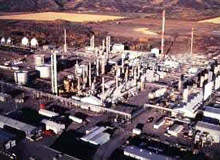
A quick turnaround in the fortunes of the global economy may be a distant dream but most analysts do expect oil and gas production to return to more healthy levels during 2010. But some say that oil production will not reach pre-recession rates, especially at some of the world's largest projects – namely Brazil, parts of Africa and Iraq. Analysts are looking more closely at natural gas, which some believe may take over as the primary energy source to ensure future world energy demand is met.
In a recent oil and gas market outlook, Ernst & Young outlined the reasons why economic recovery would be slow and fragile. While the report says the short-term fundamentals for gas remain relatively weak, the outcome of a summit like Copenhagen means environmental concerns and the push towards a low-carbon future will make natural gas increasingly attractive.
Ernst & Young LLP, Americas oil and gas sector leader Marcela Donadio said, "As Copenhagen demonstrated, environmental concerns and the focus on carbon management are clearly going to affect the future of this industry. In addition, there is still uncertainty around the future of energy policy. This has opened the door for natural gas.
"Recent transactions indicate that gas development is seen as a long-term hedge against prospective carbon emission regulations" he added.
Oil and gas analyst David Hart of London-based Westhouse is also keen to highlight that some of the biggest projects set to come on stream this year and beyond are natural gas projects. While large oil projects in Brazil, Iraq and parts of Africa may dominate the headlines, there has been a large push towards developing natural gas in other parts of the world. The continued importance of securing energy for the future, more importantly energy that is clean and low in carbon, drives the popularity natural gas.
"Natural gas is a big area – the Gorgon LNG project in Australia is an example. Qatar is also one to watch, a lot of natural gas will be coming online there," says Hart. While much has been written about the large Gorgon project, US and European suppliers have also been keen to take a bigger role in the push towards producing more and selling more natural gas.
Russian dominance and US growth
In Europe, Russian state gas giant Gazprom is being increasingly vocal about its aim to boost supply to the European and Asian markets. The company, which is one of the biggest players in the global gas game, announced at the start of 2010 that it expected a rise in gas demand as the economy returns to normal, "We expect an increase in demand for Russian gas and other supplies by 2012 or 2013 at the latest," Gazprom deputy chief executive Alexander Medvedev told media at an energy conference in Berlin in January.
Russia has shipped more than 5.5 million tons of liquefied natural gas (LNG) to the Asian markets since launching its first LNG plant on the Pacific island of Sakhalin almost a year ago. The company, which is also run by state giant Gazprom, said that the hundredth tanker from its LNG plant had arrived in Japan, which is where more than half of the LNG delivered by the company has gone to date.
Another important region to focus on will be Alaska, which is, according to energy giant ExxonMobil, currently gearing up to support US and Canadian energy demand. Speaking at a keynote address in February 2010, president of ExxonMobil Production Company, Rich Kruger, said Alaska was in the enviable position of being able to meet the natural gas requirements of the US and called for the state to "step up" in preparation to do so in 2010 and beyond. One of Alaska's biggest natural gas wells is Point Thomson and the energy giant said it was hoping to develop larger resources at the project.
Much of the future global gas demand will come from the power-generation sector, reflecting the fact that cleaner-burning natural gas is becoming the fuel of choice, according to ExxonMobil.
European LNG market
Meanwhile in Europe, at the beginning of 2010 German energy giant E.On Ruhgas announced it had been locked in expensive deals for part of the contracted gas volumes it intends to take at a later date, while cheap gas is available in spot markets. Company CEO Bernhard Reutersberg said he expected cheaper spot market conditions until 2011 as the global market for LNG on tankers expands and cheap new gas exploration in the US contributes to oversupply. He said the index linking of gas prices to oil within pipeline gas contracts should continue, although more gas is around at virtual trading hubs from new market entrants.
To add to this prediction, some industry analysts believe falling investment in oilfields means non-OPEC oil output could soon fall, raising prices and potentially derailing any global economic recovery. If this were to happen, the outlook for both oil and gas will be grim as larger oil projects become less likely to come to fruition. But if ExxonMobil is correct in its prediction that demand for natural gas is expected to be 55% higher in 2030 than in 2005, natural gas will play an increasingly prominent role in meeting the ever-growing supply-and-demand quota around the world.



